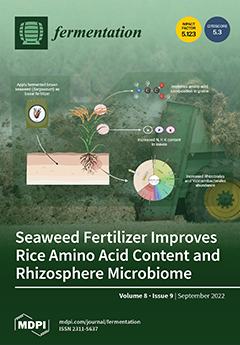The effects of the nitrogen source and buffers used in butanol production with
Clostridium beijerinckii TISTR 1461 from sweet sorghum stem juice (SSJ) containing 60 g/L of total sugar were first studied in this paper. Among the various nitrogen sources (dried spent yeast,
[...] Read more.
The effects of the nitrogen source and buffers used in butanol production with
Clostridium beijerinckii TISTR 1461 from sweet sorghum stem juice (SSJ) containing 60 g/L of total sugar were first studied in this paper. Among the various nitrogen sources (dried spent yeast, urea, ammonium acetate, ammonium sulfate), urea was found to be the most suitable for butanol production. SSJ supplemented with urea (0.64 g/L) and cocktail buffers (KH
2PO
4, 0.5 g/L; K
2HPO
4, 0.5 g/L; ammonium acetate, 2.2 g/L) gave the highest butanol concentration (
PB, 10.13 g/L). Then, the capability of immobilized
C. beijerinckii TISTR 1461 cells for butanol fermentation was investigated. Two residual waste materials were examined as immobilized cell carriers. Bamboo chopstick pieces were more appropriate as carriers for cell immobilization than cigarette filter tips. The
PB value of the immobilized cells on the bamboo chopstick pieces was ~13% higher than that on the cigarette filter tips. Using the response surface methodology (RSM), 1.9 cm bamboo chopstick pieces with a carrier loading of 1:32 (
w/
v) were the optimum conditions for cell immobilization for butanol production. Under these conditions, the
PB value was 11.62 g/L. To improve the butanol production efficiency, a gas stripping system (GS) was connected to the fermenter. It was found that the
PB (14.02 g/L) and butanol productivity (
QB, 0.29 g/L·h) values improved by ~21% compared to butanol fermentation using no gas stripping.
Full article





